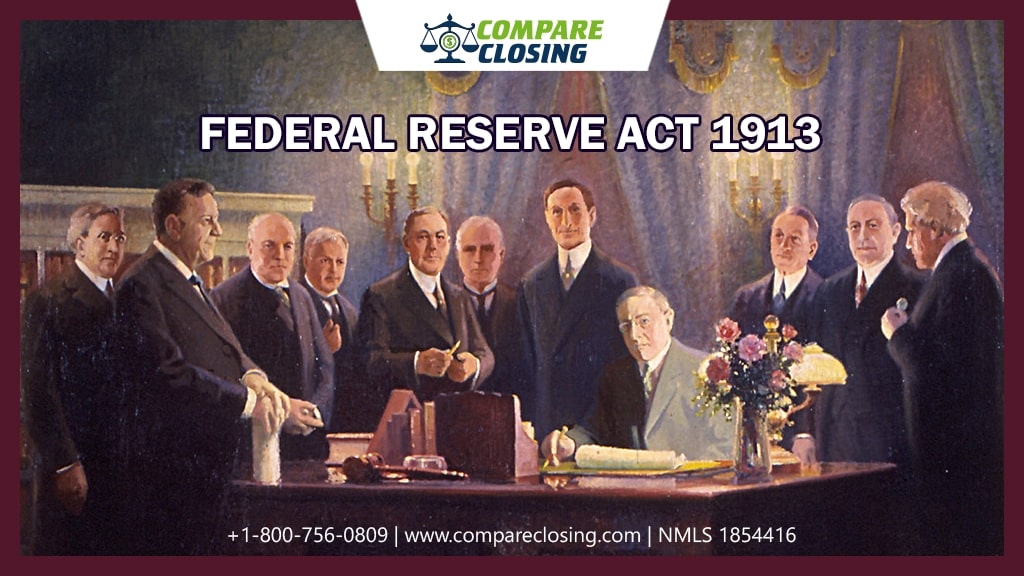Table of Contents
- What Are Netting Escrows & How Does It Work?: The Best Guide - January 2, 2024
- The Secret About Prescriptive Easement: Top Guide 1 Must Know - December 4, 2023
- About Home Equity Loans In Texas And How Can One Obtain It - November 27, 2023
About 1913 Federal Reserve Act
The 19th century was a difficult time for the American financial market. With an unstable financial market and lack of reserves, investors we skeptical about their investments in banks and other financial institutions.
After the financial crisis of 1907, it was time for the country to take some measures to stabilize the financial market.
Hence, in 1913 the Federal Reserve Act was put into action. In this post, we will understand what Federal Reserve Act is in detail.
What Is The Federal Reserve Act Of 1913?
The 1913 Federal Reserve Act is the federal law that helped to create the Federal Reserve System, the United States central banking system.
The act also created the Federal Reserve Note as the nation’s currency. President Woodrow Wilson (D) signed the law on December 23rd, 1913.
This act was enacted in response to the various financial crises that the country experienced since it was founded. Before 1913, financial events were very common as the investors were uncertain about the security of their deposits in the banks.
To stabilize the financial sector, private financers such as J.P Morgan provided lines of credit after bailing out the federal government in 1985.
The role of the act was to create a system of federal banks that printed money and controlled its supply to increase employment and reduce inflation.
This act gave Fed the power to print money and policy tools to ensure economic stability.
The Act outlines the purpose, structure, and function of the Federal Reserve System. Congress can change the Act and has done so multiple times.
What Is The History Behind the Federal Reserve Act of 1913?
In 1791, the United States Congress created the First Bank and appointed the President, Directors, and Corporation of the Bank of the United States.
First Bank was the first national bank with the United States government as a majority shareholder and was established 20 years.
However, though the government of the United States held the majority of shares, it was not controlled by the government.
In 1811, the First Bank’s charter expired and Congress refused to renew it. In 1816, a second national bank was created, known as the Second Bank. Like the first bank, the second bank was established 20 years.
The Second Bank’s charter expired in 1836, post which, the bank became private and was liquidated in 1841.
In 1895, private financier JP Morgan bailed out the federal government when its gold reserves were in danger of being depleted following a financial panic.
In 1907, the country faced another financial crisis and at the time was the only world financial power without a central bank.
This was the time when private investors such as J.P Morgan strengthened the banking system by providing investments and lines of credit.
In 1908, the National Currency Commission was created and Aldrich-Vreeland Act was passed.
The act provided for the disbursement of emergency funds and required the commission to research and suggests changes in the country’s financial system.
The 18 members of the commission were led by Senator Nelson Aldrich (R) and held hearings in the United States and traveled to major cities in Europe to learn about their financial systems.
After several years of development, the plan drawn up by federal government officials and banking experts was released by Senator Aldrich in 1911, revised, and then submitted to Congress in 1912.
The plan was not adopted because the Democratic Party opposed his plan as a plank of their party platform, winning several seats in Congress along with the presidency in the 1912 election.
In 1913, Senator Robert Latham Owen (D) and Representative Carter Glass (D) introduced similar but separate bills that allowed for the establishment of a revised national banking system. On September 18, 1913, the proposed bills passed their respective chambers.
On December 22, 1913, the Joint Committee reported the revised bill. The United States House of Representatives passed the bill on December 22, 1913, by a vote of 298-60, followed by the United States Senate on December 23, 1913, by a vote of 43-25.
Finally, on December 23, 1913, President Woodrow Wilson (D) signed the bill into law.
Conclusion
The Federal Reserve Act, also known as Currency Act or Owen Glass Act is one of the most important laws that protect the financial stability of the country.
Thanks to this Act we now have a nationwide centralized banking system, a stable financial market, and set a long-time economic growth of the country.
Amanda Byford
Amanda Byford has bought and sold many houses in the past fifteen years and is actively managing an income property portfolio consisting of multi-family properties. During the buying and selling of these properties, she has gone through several different mortgage loan transactions. This experience and knowledge have helped her develop an avenue to guide consumers to their best available option by comparing lenders through the Compare Closing business.





